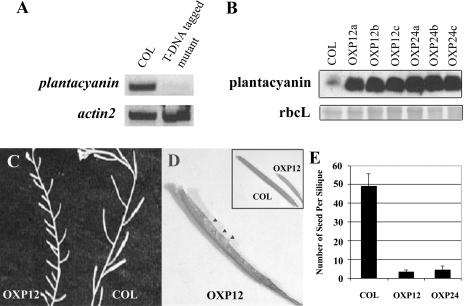Figure 3.
The T-DNA-tagged mutant is a knockdown mutant and does not show an obvious phenotype, but overexpression of plantacyanin in Arabidopsis results in reduced seed set. A, RT-PCR analysis revealed that the T-DNA-tagged mutant, with a T-DNA fragment inserted in the intron region of the Arabidopsis plantacyanin gene, is not a null allele. One microgram of total RNA extracted from inflorescences was used for RT-PCR and amplified for 30 cycles. Actin2 was amplified as a loading control. B, Plantacyanin expression levels were much higher in inflorescences of Arabidopsis OXPs (OXP12a–c and OXP24a–c; homozygous T2 plants) than in the wild type (COL). Rubisco large subunit was stained with Ponceau S as a protein-loading control. C, Siliques on the 6-week-old plants are shorter in OXP12 (T1 generation) compared to the wild type (COL). Arrowheads point to the very few seeds formed in a silique of OXP12. E, Number of seeds formed per silique in the overexpression transgenic lines showed a dramatic decrease compared with the wild type (COL). At least five siliques were randomly picked and opened for seed counts from each line. The values are mean ± sd.

